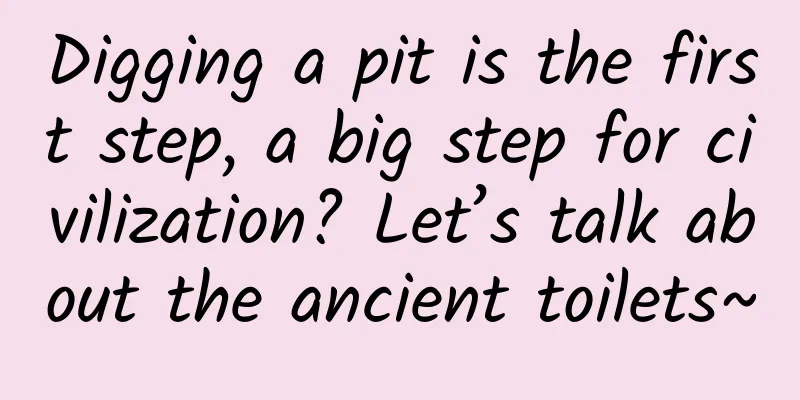Digging a pit is the first step, a big step for civilization? Let’s talk about the ancient toilets~

|
What is unexpected is that in the peak tourist season that has just passed, the popularity of many toilet review posts far exceeded that of travel guides and attraction review posts. There was even a "toilet mutual aid alliance" where netizens shared toilet guides as if they were sharing travel routes, protecting each other's last bit of "toilet dignity." At the beginning of last year, a high-level flush toilet from the Warring States period was discovered at the Qin and Han Dynasty Liyang City Ruins in Xi'an. It consisted of an indoor toilet on a platform and an outdoor sewage pit. This is the only toilet-like remains found in the archaeological excavation of Chinese palaces throughout the dynasties, and it is also the first "flush" toilet found in Chinese archaeology, dating back about 2,400 years. After this news was released, it attracted the attention of many netizens, and many of them were shocked: The ancients' toilets were so advanced? Not only that, the ancients also paid great attention to toilet etiquette... In this issue, let’s talk about ancient toilets~ Chapter. 01 Digging a pit is the first step to civilization Toilets have always been regarded as something that is not worthy of being in a respectable place. People are ashamed to mention it, but cannot do without it. The toilet is a necessary accessory facility for a house. Early humans often dug a pit to make a toilet, and filled it up when it was full. Next to the houses of the clan tribe in Banpo Village, Xi'an, there is a pit left, which is regarded as the earliest toilet in China. In the Western Zhou Dynasty, "Yili. Jixili" clearly recorded that "slaves made toilets", that is, they dug a pit to make a toilet, and when the pit was full, they asked slaves to fill it up and then dig a new pit. In order to reduce the amount of work, during the Spring and Autumn Period, the depth of the toilet pit was increased to more than twelve feet. If a person fell in, it would be difficult to climb out. During the Spring and Autumn Period, Duke Jing of Jin became the first person in recorded history to die in a toilet, falling into a pit and drowning. According to Zuo Zhuan, "The Duke of Jin was eating wheat, and he went to the toilet, fell in and died." In ancient times, the agricultural society did not produce chemical fertilizers. As society developed, our ancestors realized that "feces" could promote the growth of crops, so they took the initiative to collect "feces" and use them for agricultural production. Therefore, a new type of "toilet" was created during the Spring and Autumn Period, called "Hùn". In the Pre-Qin period, "Hùn" specifically referred to a place for raising pigs. By the end of the Spring and Autumn Period, it also had the meaning of "toilet". Yinan Beizhai Han Dynasty Stone Carvings Image source: Yinan Culture and Tourism Voice Client During the Qin and Han dynasties, toilets were no longer simply pits. A pottery building with a toilet on each side was unearthed in Tomb No. 94 of the Eastern Han Dynasty in Wuzhi, Henan Province. A Han Dynasty stone relief in Yinan preserved a life scene from the Han Dynasty: a toilet in the picture was built on stilts, with the upper part being the toilet room and the lower part being a manure pit. The toilet was surrounded by railings, and there was a large water tank outside. There was also a urinal for urination and a "yú" for manure. A woman with a broom was cleaning the toilet. A very exquisite pottery toilet was unearthed from the Eastern Han Tomb of Yangguan Temple in Nanyang, Henan. The toilet is nearly square in plan and has two doors, one leading to the women's toilet and the other to the men's toilet. It can be seen that separate toilets for men and women had already appeared at that time. Such single toilets are rarely seen in archaeological excavations of Han Dynasty relics. In most cases, the toilet and the pigpen are connected together. Western Han Dynasty red pottery toilet pigpen Image source: Henan Museum The toilet was built on top of the pigsty, with a special road and door leading to the toilet. There were some small holes on the wall of the lower pigsty, called "sinus holes", for the dung man to clean up the feces. Human excrement fell directly into the pigsty, mixed with pig feces and feed residues to ferment, called "fermentation", which is an excellent fertilizer for crops. The latrine not only saves space, but also perfectly combines the sewage disposal industry with agriculture and animal husbandry, actively implementing the green, circular and renewable development concept. Green glazed pigsty in Han Dynasty Image source: Palace Museum A large number of "pottery pig toilets" unearthed by archaeologists show that sharing toilets with pigs was very popular in the Han Dynasty. However, this "mixed toilet" gradually disappeared after the Wei and Jin Dynasties. However, many families still set up livestock pens next to the toilet. Chapter. 02 Convenience is the origin of the kingly toilet In order to make it easier to go to the toilet, the ancients were no longer limited to using fixed toilets, but invented a portable toilet called "huzi", which is what we commonly call a chamber pot, a common male urinal. Tiger chop originated in the Warring States Period and became popular in the Han and Jin Dynasties. It may have been created to satisfy the romantic and unrestrained style of the celebrities in the Wei and Jin Dynasties. Late Warring States Period Tiger Cup with Gold and Silver Inlay and Bird Pattern Image source: Palace Museum In the Tang Dynasty, since the grandfather of the founding emperor Li Yuan was named Li Hu, and the ancients paid attention to avoiding the name of the respected, the emperor's grandfather's name could not be used on toilet utensils, so "Hu Zi" was changed to "Ma Zi". Gradually, the ancients had higher requirements for toilets. They needed to be able to hold not only urine but also feces, so the shape of the toilet became larger and became a bucket shape, and the "toilet" was born. "Menglianglu" records: "Hangzhou has a large population, and most of the people in the streets and alleys have no pit toilets, only toilets." It can be seen that by the Song Dynasty at the latest, wooden "toilets" were popular in folk society. The toilet takes up little space, has little odor, is easy to clean, and has a function that exceeds that of a urinal, so it is very popular among the people. However, in ancient times, the "toilet" could not be dumped anywhere. It could be poured into the cesspool at home, or it could be collected and processed by the "poop collector". Therefore, a new profession was born. In the Tang and Song dynasties, it was called "Qiaojiaogong" and in the Ming and Qing dynasties, it was called "Fenfu". They would go around the streets and alleys to collect feces from each household, and then transport it to the countryside or "Fenza" to sell it. This can be said to be a high-paying profession. Many people make a living from it, and even make a fortune from it. It is recorded in "Chaoye Qianzai": "The family wealth is huge." Chapter. 03 It’s better to smell good than to smell bad. Two or three things about the nobles’ toilets In ancient times, nobles were very particular about going to the toilet. When the Englishman John Harrington invented the world's first flush toilet, toilets really entered a modern transformation. In ancient China, the prototype of the flush toilet appeared even earlier. A stone toilet was unearthed in the tomb of the queen of Liang Xiaowang of the Western Han Dynasty in Mangdang Mountain, Yongcheng, Henan. It is located in the corner of the tomb, with the right side and back against the wall. The toilet pit is rectangular, and the toilet seat is composed of two stone cushions, standing on both sides of the toilet pit. Below the toilet seat are two shoe-shaped footrests. The toilet also has a backrest and armrest structure, which is practical and perfectly reflects the comfort. The back of the toilet is connected to a water tank and a water pipe. Although we don't know the specific flushing process, the advanced "innovation consciousness" of our ancestors really surprised modern people. As the ancestor of flush toilets, it plays an important role in the history of toilet civilization in China. Stone toilet in the tomb of the queen of Liang Xiaowang in the Western Han Dynasty Image source: Screenshot from the first season of the documentary "Cultural Relics Online" In order to make "going to the toilet" a pleasure, the ancients put much more effort into "toilets". In addition to the hard decoration, the toilets of the nobles at that time also had many supporting "soft-package facilities". People placed incense burners in the toilets to burn incense, washed their hands with a granular substance called "bath beans", and even prepared dates to block the odor in the nostrils. Ni Zan, a "clean freak" in the Yuan Dynasty, built his own "incense toilet". According to the "Yunlin Yushi", he built a tall building with incense wood, and underneath the building there was an open wooden lattice covered with thick goose feathers. When excrement falls into the wooden grid, light and soft goose feathers will immediately fly up to cover the excrement. In addition, servants will wait below and replace new wooden grids and new goose feathers at any time to ensure that the toilet environment is clean and fragrant. Qiu Ying, Ming Dynasty: Portrait of Ni Zan Image source: China Treasure Museum In the Qing Dynasty, the royal nobles mainly used toilets when going to the toilet. There were two types of toilets: rectangular and oval. They were made of wood, tin or porcelain. The place where the toilets were stored was called the "clean room." When urinating, the urinal was filled with charcoal ash and covered tightly with ash after urination; when urinating, no charcoal ash was used. After urinating, the urinal was poured into the toilet and covered with a wooden lid. The eunuchs cleaned the urinal regularly every day. The urinals used by the emperor, concubines, etc. were called "official rooms" and were kept by special people. When needed, eunuchs or palace maids were summoned to deliver them to the "official rooms". For the sake of cleanliness, these urinals were not placed in the bedroom on weekdays. Qing Dynasty Palace Toilet Image source: The Palace Museum | Illustration from the paper "Toilet Problems in the Imperial Palaces of the Ming and Qing Dynasties" Chapter. 04 The beginning of jumping out of private space and into public toilets In addition to private toilets with their own characteristics, ancient my country also attached great importance to the construction of public toilets. As early as the pre-Qin period, China had public toilets, and there were dedicated people to manage them. "The Zhou Li Tianguan" records: "The palace people are in charge of the maintenance of the six bedrooms of the king, and they are responsible for the wells and toilets, and they remove the dirty things and the bad smells." The so-called "toi" refers to the public toilets built beside the road. There were specific building standards for public toilets at that time. "The Banner of Mozi" states: "For toilets for the people, the walls should be more than 12 feet high." The toilets were built with 2.7-meter-high walls, fully considering the privacy protection when using the toilet. In the Song Dynasty, luxurious public toilets appeared whose facilities and services were no less than those of modern star-rated toilets. During the Southern Song Dynasty, a Japanese monk who came to China to study once hand-painted a picture album called "Five Mountains and Ten Temples", in which one picture depicted the East Office of Jinshan Temple in Zhenjiang. "East Office" actually refers to the toilet. From the floor plan of the East Hall of Jinshan Temple, we can see that the public toilets at that time were quite complete. At the top is a row of toilet troughs with compartments, and outside the compartments are incense burners; at the lower right corner is a urinal, and next to it are ashes, soil, bath beans and sinks for washing hands. In the middle of the East Chamber, there is a "cleaning pole" for hanging towels, a stove for drying towels, and a fire stove for boiling soup on the left. It not only solves the problem of placing clothes and accessories when people go to the bathroom, but also provides clothing baking services and heats the toilet in winter. It can be said that it is very thoughtful. Floor plan of the East Temple of Jinshan Temple Image source: The Paper | Visiting exhibitions at museums In the Qing Dynasty, public toilet management underwent new changes, and paid toilets appeared. The earliest recorded paid public toilet in my country appeared during the Jiaqing period of the Qing Dynasty. According to "Yanjing Miscellaneous Notes", at that time "people had to pay to use public toilets in Beijing" and "people had to pay one penny to enter". Only by paying could one enter and get two pieces of toilet paper. Because it is profitable, the phenomenon of privately-owned public toilets has emerged in society. In order to attract business, toilet owners often post large, attractive canvases and billboards outside the toilets with the words "Clean Mao (thatched) Room" written on them. Novels and other books are also placed in the toilets for toilet users to read in order to attract "return customers". Throughout China's long history, people have tried their best to make "going to the toilet" an elegant thing and strive to make "going to the toilet" a kind of enjoyment, from being avoided to generously accepting it. Regardless of whether it is vulgar or elegant, toilets are indispensable to human beings. Through the creation of generations of Chinese people, it has gradually evolved into today's beautiful and high-quality urban landscape. -END- Sources: Xinhua News Agency, The Paper, Museum Exhibitions, the official website of the Palace Museum, the paper "Toilet Problems in the Imperial Palaces of the Ming and Qing Dynasties", the documentary "Cultural Relics Online Season 1" Episode 4 "Stone Toilets - Alternative History of Civilization", Urumqi Evening News "History of the Evolution of Toilets", Yangtze Evening News "Micro History | Toilets of the Ancients" Image sources: The Paper | Exhibitions at the Museum, the Palace Museum | Illustrations for the paper "Toilet Problems in the Imperial Palaces of the Ming and Qing Dynasties", China Treasure House, screenshots from the first season of the documentary "Cultural Relics Online", the Palace Museum, Henan Museum, and Yinan Culture and Tourism Voice Client Source: Chongqing Jiulongpo District Cultural Relics Management Office Audit expert: Li Xiaoying Statement: Except for original content and special notes, some pictures are from the Internet. They are not for commercial purposes and are only used as popular science materials. The copyright belongs to the original authors. If there is any infringement, please contact us to delete them. |
<<: 27 dead and 158 injured! If you find a gas leak, don't do this
>>: Cancer is different for men and women? Exploring the gender preference of cancer
Recommend
My child has a big head and short limbs. Could he be suffering from achondroplasia?
《Cotton Swab Medical Science Popularization》 Yong...
Beautiful menu animation
Source code introduction You can add beautiful an...
After Yangkang, will exercise lead to sudden death from myocarditis? How long can I exercise?
Can I resume exercise immediately after “Yang Kan...
What happens to your body if you drink a cup of yogurt every day? You will never guess the answer
Yogurt is a drink that many people love to drink....
How to plan an excellent online event?
In Philip Kotler's book " Marketing Mana...
How to create content in the tourism industry? Check out these eight super exciting examples!
Leo Tolstoy once said, “All great literature can ...
Will I get arthritis if I frequently "click" my fingers? Someone has been clicking his fingers for 60 years and found out the truth
Expert of this article: Ao Rongguang, MD, Master&...
He shot a gorilla and brought it back to life
In 1896, in what is now Somalia, Carl Akeley fire...
What special tricks do creatures living in cold areas have?
★ Short-term quick freezing will freeze animals s...
How does the training camp achieve an overall conversion rate of 81%?
I believe you must have seen various training cam...
How to promote the education industry? Education information flow advertising promotion case!
How can the education industry accurately acquire...
Can bananas cure constipation? The fruit that really relieves constipation is...
If you average a week Fewer than 3 bowel movement...
Does Tesla understand marketing?
Compared with the endless noise of domestic brand...
The reason behind advertisers' big investments in long videos: user addiction
Unlike YouTube and Hulu, which have distinct cont...
"The Biography of Zeng Guofan" - Zhang Hongjie Baidu Cloud Download
Biography of Zeng Guofan - Preface by Zhang Hongj...




![[Live] Sunflower Technical Director Zhang Xiaofeng: The first case in China to talk about the practice of MySQL InnoDB memcached plugin](/upload/images/67ebd84dbf495.webp)




